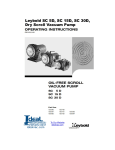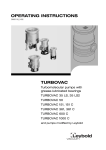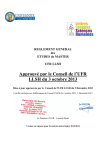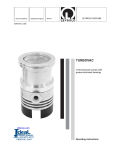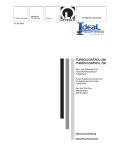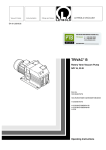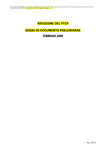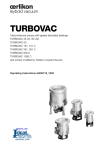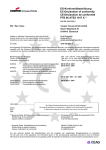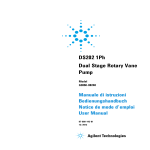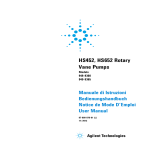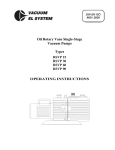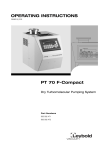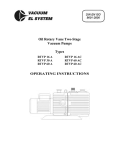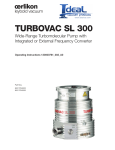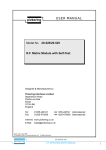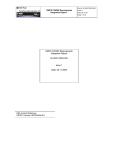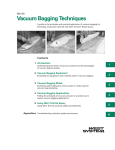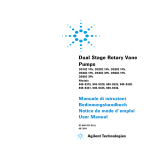Download User`s Manual - Flexcell International Corp.
Transcript
OPERATING INSTRUCTIONS GA01201_1002 TRIVAC® B D 4 B / D 8 B Rotary Vane Vacuum Pump Cat. No. 113 08/17 140 081/082 vacuum Contents Section Page Important Safety Information . . . . . . . . . . . . . . . . . . . . . . . . . . . . . . . . . . . . 6 2 GA01201_1002 - 07/2005 1 Description . . . . . . . . . . . . . . . . . . . . . . . . . . . . . . . . . . . . . . . . . . . . . . . . . . . 8 1.1 Function . . . . . . . . . . . . . . . . . . . . . . . . . . . . . . . . . . . . . . . . . . . . . . . . . . . . . . 9 1.2 Supplied Equipment . . . . . . . . . . . . . . . . . . . . . . . . . . . . . . . . . . . . . . . . . . . . 11 1.3 Accessories . . . . . . . . . . . . . . . . . . . . . . . . . . . . . . . . . . . . . . . . . . . . . . . . . . 12 1.4 Technical Data. . . . . . . . . . . . . . . . . . . . . . . . . . . . . . . . . . . . . . . . . . . . . . . . . 13 1.4.1 Motor Related Data. . . . . . . . . . . . . . . . . . . . . . . . . . . . . . . . . . . . . . . . . . . . . 13 2 Transportation . . . . . . . . . . . . . . . . . . . . . . . . . . . . . . . . . . . . . . . . . . . . . . . 14 3 Installation . . . . . . . . . . . . . . . . . . . . . . . . . . . . . . . . . . . . . . . . . . . . . . . . . . 15 3.1 Placement. . . . . . . . . . . . . . . . . . . . . . . . . . . . . . . . . . . . . . . . . . . . . . . . . . . . 15 3.2 Connection to the System. . . . . . . . . . . . . . . . . . . . . . . . . . . . . . . . . . . . . . . . 16 3.3 Electrical Connections. . . . . . . . . . . . . . . . . . . . . . . . . . . . . . . . . . . . . . . . . . . 17 3.4 Areas of Application . . . . . . . . . . . . . . . . . . . . . . . . . . . . . . . . . . . . . . . . . . . . 17 4 Operation . . . . . . . . . . . . . . . . . . . . . . . . . . . . . . . . . . . . . . . . . . . . . . . . . . . 18 4.1 Start-up . . . . . . . . . . . . . . . . . . . . . . . . . . . . . . . . . . . . . . . . . . . . . . . . . . . . . 18 4.2 Operation . . . . . . . . . . . . . . . . . . . . . . . . . . . . . . . . . . . . . . . . . . . . . . . . . . . . 18 4.2.1 Pumping of Non-Condensable Gases . . . . . . . . . . . . . . . . . . . . . . . . . . . . . . . 18 4.2.2 Pumping of Condensable Gases and Vapours . . . . . . . . . . . . . . . . . . . . . . . . 19 4.2.3 Operating Temperature . . . . . . . . . . . . . . . . . . . . . . . . . . . . . . . . . . . . . . . . . . 19 4.3 Shutdown . . . . . . . . . . . . . . . . . . . . . . . . . . . . . . . . . . . . . . . . . . . . . . . . . . . . 20 4.3.1 Shutdown through Monitoring Components . . . . . . . . . . . . . . . . . . . . . . . . . . 20 4.3.2 Failure of the Control System or the Mains Power. . . . . . . . . . . . . . . . . . . . . . 20 Contents Section Page 5 Maintenance . . . . . . . . . . . . . . . . . . . . . . . . . . . . . . . . . . . . . . . . . . . . . . . . . 21 5.1 Checking the Oil Level . . . . . . . . . . . . . . . . . . . . . . . . . . . . . . . . . . . . . . . . . . 22 5.1.1 Checking the Condition of N 62 or HE 200 Oil . . . . . . . . . . . . . . . . . . . . . . . . 22 5.2 Oil Change . . . . . . . . . . . . . . . . . . . . . . . . . . . . . . . . . . . . . . . . . . . . . . . . . . . 23 5.3 Cleaning the Inlet Screen . . . . . . . . . . . . . . . . . . . . . . . . . . . . . . . . . . . . . . . . 24 5.4 Removing and Fitting the Internal Demister . . . . . . . . . . . . . . . . . . . . . . . . . . . 24 5.5 Disassembly and Reassembly of the Electric Motor . . . . . . . . . . . . . . . . . . . . 26 5.6 Replacing the Shaft Seal . . . . . . . . . . . . . . . . . . . . . . . . . . . . . . . . . . . . . . . . . 27 5.7 Removing and Remounting the Pump Module . . . . . . . . . . . . . . . . . . . . . . . . 28 5.7.1 Removing the Pump Module. . . . . . . . . . . . . . . . . . . . . . . . . . . . . . . . . . . . . . 29 5.7.2 Remounting the Pump Module . . . . . . . . . . . . . . . . . . . . . . . . . . . . . . . . . . . . 29 5.8 Service by Leybold . . . . . . . . . . . . . . . . . . . . . . . . . . . . . . . . . . . . . . . . . . . . . 30 5.8.1 Waste Disposal of Used Pump Materials . . . . . . . . . . . . . . . . . . . . . . . . . . . . 30 5.9 Storing the Pump . . . . . . . . . . . . . . . . . . . . . . . . . . . . . . . . . . . . . . . . . . . . . . 31 5.10 Maintenance Plan . . . . . . . . . . . . . . . . . . . . . . . . . . . . . . . . . . . . . . . . . . . . . . 32 6 Troubleshooting . . . . . . . . . . . . . . . . . . . . . . . . . . . . . . . . . . . . . . . . . . . . . . 33 7 Spare Parts . . . . . . . . . . . . . . . . . . . . . . . . . . . . . . . . . . . . . . . . . . . . . . . . . . 34 EEC Declaration of Conformity . . . . . . . . . . . . . . . . . . . . . . . . . . . . . . . . . 35 EEC Manufacturer’s Declaration . . . . . . . . . . . . . . . . . . . . . . . . . . . . . . . . 36 Declaration of Contamination. . . . . . . . . . . . . . . . . . . . . . . . . . . . . . . . . . . 37 GA01201_1002 - 07/2005 3 Notes Leybold Service If a pump is returned to Leybold indicate whether the pump is free of substances damaging to health or whether it is contaminated. If it is contaminated also indicate the nature of the hazard. Leybold must return any pumps without a “Declaration of Contamination” to the sender’s address. Disposal of Waste Oil Owners of waste oil are entirely self-responsible for proper disposal of this waste. Waste oil from vacuum pumps must not be mixed with other substances or materials. Waste oil from vacuum pumps (Leybold oils which are based on mineral oils) which are subject to normal wear and which are contaminated due to the influence of oxygen in the air, high temperatures or mechanical wear must be disposed of through the locally available waste oil disposal system. Waste oil from vacuum pumps which is contaminated with other substances must be marked and stored in such a way that the type of contamination is apparent. This waste must be disposed of as special waste. European, national and regional regulations concerning waste disposal need to be observed. Waste must only be transported and disposed of by an approved waste disposal vendor. Figures The references to diagrams, e.g. (1/2) consist of the Fig. No. and the Item No. in that order. We reserve the right to modify the design and the specified data. The illustrations are not binding. 4 GA01201_1002 - 07/2005 Notes The vacuum pumps from the TRIVAC B system from Leybold ensure when properly used and when observing the information provided in these Operating Instructions, safe and reliable operation. Please read all safety related notes provided in this section and the remaining part of the Operating Instructions with care and ensure compliance. The pump must only be operated and maintained by trained staff while in the proper state and as described in these Operating Instructions. Please also note local and government requirements and regulations. Should you have any questions relating to safety, operation or maintenance of the equipment, please get in touch with your nearest Leybold Vacuum office. The icon indicates procedures that must be strictly observed to prevent hazards to persons. Warning This special icon warns about dangers caused by high electric voltages. Touching parts at a high voltage can result in immediate death. Covers which are marked with this icon must only be removed by trained electricians after having reliably disconnected the electric power source. Warning Indicates procedures that must strictly be observed to prevent damage to, or destruction of the equipment. Caution Emphasises additional application information and other useful information provided within these Operating Instructions. Note GA01201_1002 - 07/2005 5 Safety information Important Safety Information Warning Non-compliance with the following precautions can result in severe injury! ■ Before beginning with any maintenance or service work on the TRIVAC B, disconnect the pump from all power supplies. ■ Do not operate the pump with any of the covers removed. Serious injury may result. ■ If exhaust gases must be collected or contained, do not allow the exhaust line to become pressurised. ■ Make sure that the gas flow from the exhaust port is not blocked or restricted in any way. ■ The standard version of the TRIVAC B is not suited for operation in explosion hazard areas. For this purpose there are special TRIVAC B Atex Pumps. Contact us before planning to use the pump under such circumstances. ■ Before starting up for the first time, the motor circuit must be equipped with a suitable protective motor switch. Please take note of the information in these Operating Instructions or on the electric motor (wiring diagram). ■ The TRIVAC B is not suited for pumping of: ■ combustile and explosive gases and vapours ■ radioactive and toxic substances ■ pyrophorous substances ■ Avoid exposing any part of the human body to the vacuum. ■ Never operate the TRIVAC B without a connected intake line or blank flange at the intake port. ■ The location at which the TRIVAC B (including its accessories) is being operated should be such that angles over 10° from the vertical are avoided. ■ The location of the TRIVAC B should be such that all controls are easily accessible. ■ Under certain ambient conditions the TRIVAC B may attain a temperature of over 70 °C (158 °F). There then exists the danger of receiving burns. Note the symbols on the pump pointing to the hazards, and in the case of a hot pump wear the required protective clothing. ■ The noise level of the TRIVAC B is between 52 and 62 dB(A). Introduce suitable hearing protection. Warning ■ Before pumping oxygen (or other highly reactive gases) at concentrations exceeding the concentration in the atmosphere (> 21 % for oxygen) it will be necessary to use a special pump. Such a pump will have to be modified and degreased, and an inert special lubricant (like PFPE) must be used. ■ Before commissioning the TRIVAC B, make sure that the media which are to be pumped are compatible with each other so as to avoid hazardous situations. All relevant safety standards and regulations must be observed. 6 GA01201_1002 - 07/2005 Safety information ■ It is recommended to always operate the TRIVAC B with a suitable exhaust line which is properly connected. It must slope down and away from the pump. ■ When moving the TRIVAC B always use the allowed means only. The pump is equipped as standard with a handle. ■ Do not allow the ingestion of small objects (screws, nuts, washers, pieces of wire, etc.) through the inlet port. For this reason always use the inlet screen which is supplied as standard. Caution Non-compliance with the following precautions can cause damage to the pump! ■ Do not use the pump for applications that produce abrasive or adhesive powders or condensable vapours that can leave adhesive or high viscosity deposits. When planning to pump vapours other than water vapour please contact our sales or service department for advice. ■ This pump is suited for pumping water vapour within the specified water vapour tolerance limits. ■ Avoid vapours that can condense into liquids when being compressed inside the pump, if these substances exceed the vapour tolerance of the pump. ■ Before pumping vapours the TRIVAC B should have attained its operating temperature. This will be the case approximately 30 minutes after having started the pump. During this warming up phase, the pump should be separated from the process, by a blocking valve in the intake line, for example. ■ In the case of wet processes we recommend the installation of liquid separators upstream and downstream of the pump as well as the use of the gas ballast. ■ The exhaust line should be laid so that it slopes down and away from the pump so as to prevent condensate from backstreaming into the pump. ■ The entry of particles and fluids must be avoided under all circumstances. ■ Reactive or aggressive substances in the pump chamber may impair the operating oil or modify it. In addition, such substances may be incompatible with the materials of the pump (Viton, grey cast iron, aluminium, steel, resins, glass etc.). ■ Corrosion, deposits and cracking of oil within the pump are not allowed. ■ Normal amounts of humidity within the range of the pump’s water vapour tolerance will not significantly affect pump performance when the gas ballast is active. This information serves the purpose of making optimum use of the pump! In the case of custom pumps (with a part number deviating from that stated in the EC Declaration of Conformity) please note the information provided in the supplementary sheet. Caution GA01201_1002 - 07/2005 7 Description 1 2 3 Key to Fig. 1 1 Oil filter OF 4-25 2 Exhaust filter AF 4-8 3 Condensate trap AK 4-8 Fig. 1 TRIVAC B with accessories 1 Description TRIVAC B pumps are oil-sealed rotary vane pumps. The TRIVAC D 4 B and D 8 B are dual-stage pumps. The number in the type designation (4 or 8) indicates the pumping speed in m3 · h-1. TRIVAC B pumps are capable of pumping gases and vapours and evacuating vessels or vacuum systems down into with the medium vacuum range. The standard versions of the pump are not suited for pumping of oxygen exceeding the concentration as found in the atmosphere, and are also not suited for pumping of hazardous gases or extremely aggressive or corrosive media. The drive motor of the TRIVAC B is directly flanged to the pump at the coupling housing. The pump and motor shafts are directly connected by a flexible coupling. The bearing points of the pump module are force lubricated sliding bearings. All controls as well as the oil-level glass and the nameplate are arranged on the front. All connections are to be found at the sides of the pump. The oil-level glass is provided with prisms for better observation of the oil level. The pump module consists of assembly parts which are pin-fitted so as to allow easy disassembly and reassembly. The pump module can be easily removed without special tools. 8 GA01201_1002 - 07/2005 Description 1 Key to Fig. 2 1 Intake port 2 Inlet screen 3 Anti-suckback valve 4 Intake channel 5 Vane 6 Pump chamber 7 Rotor 8 Cover plate, connection for inert gas ballast 9 Exhaust channel 10 Exhaust valve 11 Internal demister 12 Spring buckles 13 Cover plate, connection for oil filter 13 2 12 3 11 4 10 5 9 8 7 6 Fig. 2 Sectional drawing of the TRIVAC B 1.1 Function The rotor (2/7), mounted eccentrically in the pump chamber (2/6), has two radially sliding vanes (2/5) which divide the pump chamber into several compartments. The volume of each compartment changes periodically with the rotation of the rotor. Operating Principle As a result, gas is sucked in at the intake port (2/1). The gas passes through the inlet screen (2/2), flows past the open anti-suckback valve (2/3) and then enters the pump chamber (2/6). In the pump chamber, the gas is passed on and compressed, after the inlet aperture is closed by the vane. The oil injected into the pump chamber is used for sealing and lubricating. The slap noise of the oil in the pump which usually occurs when attaining the ultimate pressure is prevented by admitting a very small amount of air into the pump chamber. The compressed gas in the pump chamber is ejected through the exhaust valve (2/10). The oil entrained in the gas is coarsely trapped in the internal demister (2/11); there the oil is also freed of mechanical impurities. The gas leaves the TRIVAC B through the exhaust port. Oil filter During compression, a controlled amount of air - the so-called gas ballast - can be allowed to enter the pump chamber by opening the gas ballast valve (position I). The gas ballast stops condensation of vapours in the pump chamber up to the limit of water vapour tolerance as specified in the technical data for the pump. Operating with gas ballast GA01201_1002 - 07/2005 9 Description The gas ballast valve is opened (position I) and closed (position 0) by turning the gas ballast knob (7/5) on the front. Lubrication system To enable the TRIVAC B to be used at intake pressures as high as 1,000 mbar, a special lubricating system was developed featuring force-lubrication of the sliding bearings. An oil pump (3/6) pumps the oil from the oil reservoir (3/5) into a pressurelubrication system which supplies oil to all bearing points (3/2). From there the oil enters the pump chamber area (2/6) of the vacuum pump. The oil pump is fitted in the front end plate on the coupling side of the pump module. The oil suction line is placed low, resulting in a large usable oil reservoir. Seperation of oil and gas The oil is separated from the gas in the TRIVAC B in two steps as described above. First, small droplets are coalesced into large drops in the internal demister (2/11) fitted above the exhaust valve (2/10). Then, the large drops fall into the oil reservoir as the exhaust gas is diverted by the inner walls of the oil case. Thus a low loss of oil is obtained. This and the large usable oil reservoir ensure long intervals between oil changes even at high intake pressures. Anti-suckback valve The vacuum is maintained by the TRIVAC B by an integrated hydropneumatic anti-suckback valve (2/3) which is controlled via the oil pressure. During operation of the TRIVAC B the control piston (4/3) remains sealed against a spring (4/2) by the oil pressure. The valve disc (4/6) of the antisuckback valve is held at the lower position by its own weight (valve open). When the pump stops (because it has been switched off or because of a failure), the oil pressure drops and the spring (4/2) presses the control piston (4/3) up. Thus a connection is provided between the oil case or the oil reservoir (4/1) and the piston (4/4) of the anti-suckback valve. Due to the pressure difference between the oil case and the intake port the oil presses the piston (4/4) up and the valve plate (4/6) against the valve seat (4/5). The quantity of oil in the oil reservoir (4/1) prevents the entry of air into the intake port (2/1) at the beginning of this process. After the oil has flowed out from the reservoir and when the valve plate rests on the valve seat, air follows in, which vents the pump chamber and forces the valve disc (4/6) against its seat. This effectively prevents backstreaming of oil. The anti-suckback valve (2/3) operates independently of the operating mode of the pump, i.e. also with gas ballast. 10 GA01201_1002 - 07/2005 Description Key to Fig. 3 1 Accessories 2 Bearings 3 Non-return valve 4 Pump chamber of the TRIVAC 5 Oil reservoir 6 Oil pump Fig. 3 Schematic of the lubricating system Key to Fig. 4 1 Oil reservoir 2 Spring 3 Control piston 4 Anti-suckback piston 5 Valve seat 6 Valve disk 7 Gas inlet Fig. 4 Hydropneumatic anti-suckback valve 1.2 Supplied Equipment The equipment supplied with the TRIVAC-B pump includes: Pump with motor, including initial filling of N 62 or HE-200 oil. 1 centering ring, 1 centering ring with dirt trap, 2 clamping rings DN 25 KF. As protection during shipment, the connection ports are each blanked off by rubber diaphragms and supporting rings. TRIVAC-B pumps with single-phase AC motor are supplied ready to operate with switch, built-in thermal motor protection switch. A mains cable must be ordered additionally: ■ 100 V - 120 V (NEMA) ■ 200 V - 240 V (NEMA) ■ 200 V - 240 V (EURO) Note Cat.-No.: 200 81 090 Cat.-No.: 200 81 141 Cat.-No.: 200 81 091 GA01201_1002 - 07/2005 11 Description 1.3 Accessories Cat.-No. Seperator AK 4-8, DN 16 KF 188 06 Exhaust filter AF 4-8, DN 16 KF 189 06 Drain trap for Seperator, exhaust-filter, oil drain of the pump, vacuum tight oil tight 190 90 190 91 Exhaust filter with lubricant return AR 4-8, DN 16 KF 189 20 Dust filter FS 2-4 186 05 Fine vacuum adsorption trap FA 2-4 (with zeolithe) 187 05 adsorption trap (with aluminium oxide) 854 14 adsorption trap (with cryo insert) 854 17 Cold trap TK 4-8 188 20 Oil filter OF 4-25 101 91 Chemical filter CF 4-25 101 96 Adapter für gas ballast port M 16 x 1,5 - DN 16 KF M 16 x 1,5 - 3/8 inch NPT Oil N 62 168 40 99 175 011 1l 177 01 5l 177 02 20 l 177 03 1 qt 98 198 006 12 qt case 98 198 049 1 gal 98 198 007 5 gal 98 198 008 (order from Leybold, Cologne) Oil HE-200 (order from LHVP, Export Pa., USA) The oil grades N 62 and HE-200 are interchangeable. Special oils upon request. Caution 12 GA01201_1002 - 07/2005 Only use the kind of oil specified by Leybold. Alternative types of oil are specified upon request. Description 1.4 Technical Data Nominal pumping speed Pumping speed 1) 1) Ultimate partial pressure without gas ballast Ultimate total pressure without gas ballast Ultimate total pressure with gas ballast Water vapor tolerance 1) 1) 1) 1) Water vapor capacity Oil filling, min./max. TRIVAC D 4 B two-stage TRIVAC D 8 B two-stage m3 · h-1 4.8 9.7 m3 · h-1 4.2 8.5 mbar 10-4 mbar < 2 · 10-3 mbar < 5 · 10-3 mbar 30 25 gm · h-1 93 157 0.3 / 0.8 0.3 / 0.9 l Noise level * to DIN 45 635, (without/with gas ballast) dB (A) 50 - 52 Admissible ambient temperature °C 12 - 40 Motor rating * W 370 min-1 1500 Nominal speed * Type of protection IP Weight * kg Connections, intake and exhaust side 54 18.7 21.2 DN 16 KF 1)To DIN 28 400 and subsequent numbers *)Lenght, weight, motor rating, nominal speed and noise levels for the pumps with AC motor, 230 V, 50 Hz, only. Note 1.4.1 Motor Related Data D4B Cat. No. We can only guarantee that the pump will meet its specifications when using the type of lubricant which has been specified by us. D8B l W (kg) Cat. No. l W (kg) (mm) (mm) 113 07 223 10.6 113 17 248 12.8 140 081 455 19.1 140 082 480 21.1 Motor connections voltage, frequency Motor power ohne Motor - 100 V-120 V, 50 Hz/60 Hz* 1~ 200 V-240 V, 50 Hz/60 Hz* 570 W/660 W Rated current 7.7/5.6 A 4.0/2.8 A Speed - P/N motor - 1420/1690 10000 2292 *)a mains cable must be ordered additionally: ■ 100 V - 120 V (NEMA) Cat.-No.: 200 81 090 ■ 200 V - 240 V (NEMA) Cat.-No.: 200 81 141 ■ 200 V - 240 V (EURO) Cat.-No.: 200 81 091 GA01201_1002 - 07/2005 13 Transportation and Storage -5 10 10 -4 -3 10 -2 10 10 10 -1 1 10 Torr 750 50 D8B m3 x h-1 cfm D4B Pumping speed 10 10 Ultimate partial pressure without gas ballast Ultimate total pressure without gas ballast Ultimate total pressure with gas ballast 2 1 10 5 0 1 0.5 0.1 10 -1 -5 10 -4 10 -3 -1 -2 10 10 10 10 0 3 1 10 10 mbar Pressure Fig. 5 Pumping speed characteristics of the TRIVAC D 4 B and TRIVAC D 8 B, 50 Hz operation, SI units b b2 DN a c h h3 h1 h2 n o m l Type b1 DN a b b1 b2 c h h1 h2 h3 D 4 B (Cat.No. 140 081) 16 KF 75 162 147 132 100 265 215 200 230 D 8 B (Cat.No. 140 082) 16 KF 100 - - - - - - - - l m 455 198 480 - n o 99 108 - - Dimensions in mm Fig. 6 Dimensional drawing for the TRIVAC rotary vane pumps (Dimensions a, l, b to b2 and h1 are approximate) 2 Transportation and Storage Caution ■ Pumps which are filled with operating agents must only be moved while standing upright. Otherwise oil may escape. Avoid any other orientations during transport. Warning ■ Check the pump for the presence of any oil leaks, since there exists the danger that someone may slip on spilt oil. ■ When lifting the pump you must make use of the crane eyes provided on the pump for this purpose; also use the recommended type of lifting device. 14 GA01201_1002 - 07/2005 Installation Key to Fig. 7 1 Eye for moving the pump 2 Intake port 3 Exhaust port 4 Oil-level glass 5 Gas ballast knob 6 Threaded connection M 16 x 1.5 for inert gas ballast 7 Adapter 8 Cover plate 9 Cover plate; connection for oil filter Fig. 7 Connections and controls 3 Installation 3.1 Placement The standard pump is not suited for installation in the explosion hazard areas. When planning such an application please contact us first. Warning The TRIVAC B pump can be set up on a flat, horizontal surface. Rubber feet under the coupling housing ensure that the pump can not slip. If you wish firmly install the pump in place, insert bolts through bore holes in the rubber feet. Max. tilt for the pump (without further attachment) with possibly fitted standard accessories is 10° from the vertical. Caution The rubber feet act as vibration absorbers. They must therefore not be compressed by screws. When installing the TRIVAC B pump, make sure that the connections and controls are readily accessible. The site chosen should allow adequate air circulation to cool the pump (keep front and rear unobstructed). The ambient temperature should not exceed +40 °C (104 °F) and not drop below +12 °C (55 °F) (see Section 4.2.3). The max. amount of heat given off approximately corresponds to the rated motor power. GA01201_1002 - 07/2005 15 Installation 3.2 Connection to the System Before connecting the TRIVAC B, remove the shipping seals from the connection flanges (7/2) and (7/3). Caution Retain the shipping seals in case you need to store the pump in the future. The pump is shipped with intake and exhaust flanges mounted for horizontal connection of the connecting lines. You can easily convert the ports for vertical connection by removing the four capscrews, rotating the flanges as required, and reinstalling the capscrews. Connect the intake and exhaust lines with a centering ring and a clamping ring each. Use the centering ring with dirt trap for the intake port. Connect the intake and exhaust line using anti-vibration bellows, without placing any strain on the pump. The intake line must be clean. Deposits in the intake line may outgas and adversely affect the vacuum. The connecting flanges must be clean and undamaged. The maximum throughput of the pump is equivalent to the pumping speed of the pump (see Section 1.4). Caution The cross-section of the intake and exhaust lines should be at least the same size as the connection ports of the pump. If the intake line is too narrow, it reduces the pumping speed. If the exhaust line is too narrow, overpressures may occur in the pump; this might damage the shaft seals and cause oil leaks. The maximum pressure in the oil case must not exceed 1.5 bar (absolute). When pumping vapours, it is advisable to install condensate traps on the intake and exhaust sides. Install the exhaust line with a downward slope (lower than the pump) so as to prevent condensate from flowing back into the pump. If this is not possible, insert a condensate trap. The exhaust gases from the vacuum pump must be safely led away and subjected to post-treatment as required. In order to reduce the emission of oil vapours we recommend the installation of an additional exhaust filter (Leybold accessory). Depending on the type of application or the kind of pumped media, the corresponding regulations and information sheets must be observed. The pumps may be operated with an inert gas ballast via a connection which is provided for this purpose. The cover plate (7/8) can be removed to gain access to this M 16 x 1.5 threaded port (7/6). Matching connectors are available (see Section 1.3). In inlet pressure for the gas ballast should be about 1000 mbar (absolute) and sufficient quantities of gas must be available (about 1/10 of the pumping speed). Warning Never operate the pump with a sealed exhaust line. There is the danger of injury. Before starting any work on the pump, the personnel must be informed about possible dangers first. All safety regulations must be observed. 16 GA01201_1002 - 07/2005 Installation 3.3 Electrical Connections Before wiring the motor or altering the wiring, ensure that mains supply for the pump is off and that it can not be applied inadvertently. Warning In order to prevent the pump from running up unexpectedly after a mains power failure, the pump must be integrated in the control system in such a way that the pump can only be switched on again manually. This applies equally to emergency cut-out arrangements. The connections must only be provided by a trained electrician or must be supervised by a trained electrician working in accordance with the currently valid IEC (International), EN (European) or national guidelines. Observe all safety regulations. TRIVAC B pumps are available with a single-phase motor. With a single-phase AC motor the pumps may be connected directly to the mains via the mains cord and the mains plug. Fusing must always be done in accordance with the national and local regulations for single phase mains (in Germany 16 amps, for example). The direction of rotation need not be checked as it is fixed. The motor is protected against overloading by a thermal overload switch with automatic resetting. If the thermal overload protector shuts off the pump, the motor will restart itself as soon as it cools. That’s why the mains plug should be disconnected from the mains before starting with any work on the pump. 3.4 Warning Areas of Application Before pumping oxygen (or other highly reactive gases) at concentrations exceeding the concentration in the atmosphere (> 21 % for oxygen) it will be necessary to use a special pump. Such a pump will have to be modified and degreased, and an inert special lubricant (like PFPE) must be used. Warning The TRIVAC B is not suited for pumping of: ignitable and explosive gases or vapours oxidants ■ pyrophorous gases. ■ ■ The pumps are not suited for pumping of liquids or media which carry large quantities of dust. Corresponding protection devices need to be provided. Caution The standard pump is not suited for pumping of hazardous gases or vapours. Warning Our technical sales department is available for further advice in these matters. GA01201_1002 - 07/2005 17 Installation 4 Operation 4.1 Start-up Each time before starting up check the oil level. On initial start-up, after prolonged idle periods or after an oil change, the specified ultimate pressure cannot be attained until the oil is degassed. This can be done by running the pump for approx. 30 min. with the intake line closed and the gas ballast valve (7/5) open. Warning Before starting the pump ensure that the pump and the fitted accessories meet the requirements of your application and that safe operation can be guaranteed. Avoid exposure of any part of the body to the vacuum. There is the danger of injury. Never operate the pump with an open intake port. Vacuum connections as well as oil-fill and oil-drain openings must never be opened during operation. The safety regulations which apply to the application in each case must be observed. This applies to installation, operation and during maintenance (service) as well as waste disposal and transportation. 4.2 Operation TRIVAC B pumps can pump condensable gases and vapours, provided that the gas ballast valve (7/5) is open and the pump has attained its operating temperature. 4.2.1 Pumping of Non-Condensable Gases and Vapours If the process contains mainly permanent gases, the TRIVAC B may be operated without gas ballast (position 0), provided that the saturation vapour pressure at operating temperature is not exceeded during compression. If the composition of the gases to be pumped is not known and if condensation in the pump cannot be ruled out, run the pump with the gas ballast valve open in accordance with Section 4.2.2. 18 GA01201_1002 - 07/2005 Installation 4.2.2 Pumping of Condensable Gases and Vapours With the gas ballast valve open (position I) and at operating temperature, TRIVAC B pumps can pump pure water vapour up to the water vapour tolerance specified by the technical data. If the vapour pressure increases above the permissible level, the water vapour will condense in the oil of the pump. When pumping vapours ensure that the gas ballast valve is open and that the pump has been warmed up for approximately 30 minutes with the intake line closed. Vapour phases may only be pumped up to the permissible limit after the pump has attained its operating temperature. Caution During pumping, vapours may dissolve in the oil. This changes the oil properties and thus there is a risk of corrosion in the pump. Therefore, don’t switch off the pump immediately after completion of the process. Instead, allow the pump to continue operating with the gas ballast valve open and the intake line closed until the oil is free of condensed vapours. We strongly recommend operating the TRIVAC B in this mode for about 30 minutes after completion of the process. In cyclic operation, the TRIVAC B should not be switched off during the intervals between the individual working phases (power consumption is minimal when the pump is operating at ultimate pressure), but should continue to run with gas ballast valve open and intake port closed (if possible via a valve). Once all vapours have been pumped off from a process (e.g. during drying), the gas ballast valve can be closed to improve the attainable ultimate pressure. 4.2.3 Operating Temperature Proper operation of the TRIVAC B is ensured in the ambient temperature range between 12 °C to 40 °C (55 °F to 104 °F). At operating temperature, the surface temperature of the oil case may lie between 40 °C and over 70 °C (104 °F and 156 °F), depending on the load. The surface temperature of the TRIVAC B pumps may rise above 70 °C. Warning There is the danger of receiving burns. GA01201_1002 - 07/2005 19 Installation 4.3 Shutdown Under normal circumstances, all that you need do is to electrically switch off the TRIVAC B. No further actions will be required. When pumping condensable media let the pump continue to operate with the gas ballast valve open and the intake line closed before switching off (see Section 4.2.2). When pumping aggressive or corrosive media, let the pump continue to operate even during long non-working intervals (e.g. overnight) with the intake line closed and the gas ballast valve open. This avoids corrosion during idle periods. If the TRIVAC B is to be shutdown for an extended period after pumping aggressive or corrosive media or if the pump has to be stored, proceed as follows: Warning When having pumped harmful substances, take adequate safety precautions. Our technical sales department is available for further advice in these matters. Drain the oil (see Section 5.2). Add clean oil until the oil-level is at the „min“ mark (see Section 5.2) and let the pump operate for some time. Then drain the oil and add clean oil until the oil level is at the „max“ mark (see Section 5.2). Seal the connection ports. Special conservation or anti-corrosion oils aren’t necessary. Caution Please also take note of the information given in Section 5.9 (Storing the Pump). 4.3.1 Warning When the pump has been switched off due to overheating sensed by the motor coil protector or other monitoring components at the pump (e. g. thermal sensor), the pump must only be started manually after the pump has cooled down to the ambient temperature and after having removed the cause first. 4.3.2 Warning 20 GA01201_1002 - 07/2005 Shutdown through Monitoring Components Controller/Mains Power Failure In order to prevent the pump from running up unexpectedly after a mains power failure, the pump must be integrated in the control system in such a way that the pump can only be switched on again manually. This applies equally to emergency cut-out arrangements. Operation 5 Maintenance Disconnect the electrical connections before disassembling the pump. Make absolutely sure that the pump cannot be accidentally started. Warning If the pump has pumped harmful substances, contrary to what has been stated in Section 3.4, ascertain the nature of hazard and take adequate safety measures. Observe all safety regulations. Whenever you send a pump to Leybold, indicate whether the pump is contaminated or is free of substances which could pose a health hazard. If it is contaminated, specify exactly which substances are involved. You must use the form we have prepared for this purpose; we will forward the form on request. Contamination A copy of the form is printed at the end of these operating instructions: „Declaration of contamination of vacuum equipment and components“. Another suitable form is available from the Leybold homepage: http://www.leybold.com under the headline “Support & Download”. Form Attach the form to the pump or enclose it with the pump. Do not put the form in the polyethylen bag together with the pump. This statement detailing the contamination is required to satisfy legal requirements and for the protection of our employees. Pumps which are not accompanied by a contamination statement will be returned to the sender. When disposing of used oil, you must observe the applicable environmental regulations. Caution Due to the design concept, TRIVAC B pumps require very little maintenance when operated under normal conditions. The work required is described in the sections below. In addition to this, a maintenance plan is provided in Section 5.10. All work must be carried out by suitably trained personnel. Maintenance or repairs carried out incorrectly will affect the life and performance of the pump and may cause problems when filing warranty claims. LEYBOLD offers practical courses on the maintenance, repair, and testing of TRIVAC B pumps. Further details are available from LEYBOLD on request. Caution Caution If the TRIVAC B is used in ambient air which is much contaminated, make sure that the air circulation and the gas ballast valve are not adversely affected. Please take the spare parts numbers from the enclosed spare parts list. In case of special designs and variants please always indicate the special, variant and serial number. GA01201_1002 - 07/2005 21 Maintenance 1 2 Key to Fig. 9 1 Oil-fill plug 2 Oil-level mark maximum 3 Oil-level mark minimum 4 Oil-drain plug 3 4 Fig. 9 Oil change 5.1 Checking the Oil Level During operation of the TRIVAC B the oil level must always remain between marks (9/2) and (9/3) on the oil-level glass. The amount of oil must be checked and topped up as required. Caution Fill in oil only after the pump has been switched off. 5.1.1 Checking the Condition of N 62 or HE 200 Oil The ageing process for the standard operating fluid N 62 respectively HE 200 (see Section 1.2) will depend very much on the area of application for the pump. a) Visual check Normally the oil is clear and transparent. If the oil darkens, it should be changed. b) Chemical check The neutralisation number of N 62 oil is determined according to DIN 51558. If it exceeds 2, the oil should be changed. c) Viscosity check If the viscosity of N 62 at 25 °C exceeds a level of 240 mPas (20 % higher than the viscosity of fresh oil) an oil change is recommended. If gases or liquids dissolved in the oil result in a deterioration of the ultimate pressure, the oil can be degassed by allowing the pump to run for approx. 30 min. with the intake port closed and the gas ballast valve open. When wanting to check the oil, switch off the pump first and drain out from the warm pump the required amount of oil through the oil drain (9/4) into a beaker or similar. Caution 22 GA01201_1002 - 07/2005 Please note the safety information given in Section 5.2 Maintenance 5.2 Oil Change Before pumping oxygen (or other highly reactive gases) at concentrations exceeding the concentration in the atmosphere (> 21 % for oxygen) it will be necessary to use a special pump. Such a pump will have to be modified and degreased, and an inert special lubricant (like PFPE) must be used. Warning Hazardous substances may escape from the pump and the oil. Take adequate safety precautions. For example wear gloves, face protection or breathing protection. Observe all safety regulations. For proper operation of the pump, it is essential that the pump has an adequate supply of the correct and clean oil at all times. The oil must be changed when it looks dirty or if it appears chemically or mechanically worn out (see Section 5.1.1). The oil should be changed after the first 100 operating hours and then at least every 2,000 to 3,000 operating hours or after one year. At high intake pressures and intake temperatures and/or when pumping contaminated gases, the oil will have to be changed much more frequently. Further oil changes should be made before and after long-term storage of the pump. If the oil becomes contaminated too quickly, install a dust filter and/or oil filter (see Section 1.3). Contact us for more information in this matter. Only change the oil after the pump has been switched off and while the pump is still warm. Caution Required tool: Allen key 8 mm. Remove the oil-drain plug (9/4) and let the used oil drain into a suitable container. When the flow of oil slows down, screw the oil-drain plug back in, briefly switch on the pump (max. 10 s) and then switch it off again. Remove the oil-drain plug once more and drain out the remaining oil. Screw the oil-drain plug back in (check the gasket and reinstall a new one if necessary). Remove the oil-fill plug (9/1) and fill in with fresh oil. Screw the oil-fill plug (9/1) back in. If there is the danger that the operating agent may present a hazard in any way due to decomposition of the oil, or because of the media which have been pumped, you must determine the kind of hazard and ensure that all necessary safety precautions are taken. Torque for the oil-fill plug (9/1): Gasket: P/N: 239 55 165 10 Nm Torque for the oil-drain plug (9/4): Gasket: P/N.: 239 55 165 10 Nm We can only guarantee that the pump operates as specified by the technical data if the lubricants recommended by us are used. Warning Torques Caution GA01201_1002 - 07/2005 23 Maintenance 5.3 Cleaning the Inlet Screen A wire-mesh sieve is located in the intake port of the pump to act as a dirt trap for coarse particles. It should be kept clean to avoid a reduction of the pumping speed. For this purpose, remove the inlet screen (2/2) from the intake port and rinse it in a suitable vessel with solvent. Then thoroughly dry it with compressed air. If the inlet screen is defective, replace it with a new one. Caution The cleaning intervals depend on the application. If the pump is exposed to large amounts of abrasive materials, a dust filter should be fitted into the intake line. 5.4 Removing and Fitting the Internal Demister Required tools: Allen keys SW 5 and SW 8. Required spare parts: Allen keys 5 mm and 8 mm. The internal demister is spring-mounted in a frame. When it is clogged, it rises periodically to reduce the pressure difference created. The resultant noise at high intake pressures indicates that the internal demister is dirty. Periodically clean or replace the internal demister; the maintenance interval depends on the application. Use a suitable solvent for cleaning. Shutdown the pump and drain the oil (see Section 5.2). Pull the handle upward. Remove the four recessed screws (10/5) on the oil case (10/1). Don’t remove the non-recessed screws; they hold the motor flange in place. Pull the oil case forward off the pump. Remove the gasket (10/7). Press the spring buckles (10/2) sideways away from the frame (10/4). Lift off the frame (10/4) and remove the internal demister (10/3). Clean all parts and check that they are in perfect condition; if not, replace them with new parts. Reassemble in the reverse order. Caution 24 GA01201_1002 - 07/2005 Torque for the screws (10/5) is 5 Nm. Maintenance Key to Fig. 10 1 Oil case 2 Spring buckles 3 Demister 4 Frame for demister 5 Hex. socket screws (4 pcs.) 6 Slencing nozzle 7 Gasket Fig. 10 Removal and fitting of the internal demister Key to Fig. 11 1 Gasket 2 Handle 3 Coupling 4 Threaded pin 5 Only for USA motors: adapter flange 6 Electric motor 7 Hex. socket screws 8 Intermediate flange 9 Hex. socket screw Fig. 11 Disassembly and reassembly of the electric motor GA01201_1002 - 07/2005 25 Maintenance 5.5 Warning Disassembly and Reassembly of the Electric Motor Before starting work, always disconnect the motor from the mains. Pull the mains plug. Required tools: Allan keys size 2,5, size 3 size 5 and size 6. Possibly a puller for the coupling. Place the pump on its front side. Unscrew the four non-recessed hex. socket screws (11/7). Remove the intermediate flange (11/8) together with the electric motor (11/6). Remove the gasket (11/1). Remove the handle (11/2). Loosen the threaded pin (11/4) and pull the coupling (11/3) with the blade wheel off the motor shaft. Unscrew the hex. socket screws (11/9). Remove the electric motor (11/6) (and the adapter flange (11/5) in the case of the USA motors). Clean all parts and check that they are in perfect condition; if not, replace them with new parts. Reassemble in the reverse order. Caution 26 GA01201_1002 - 07/2005 In the case of 60 Hz motors (USA versions) with adapter flange the coupling must not be pushed on to the shaft right up to the stop. On the other hand if it is not pushed on far enough the pump module may be damaged during operation. Push the coupling on in such a way that the distance between the front end of the coupling (11/3) and front side of the adapter flange (11/5) amounts to 41.3 ± 0.8 mm (1 5/8 ± 1/32 inch) (see Fig. 11). The adapter flange (11/5) is screwed to the motor flange with four additional screws. Maintenance Key to Fig. 12 1 Coupling element 2 Hexagon socket screw 3 Spring washer 4 Coupling (one half) 5 Key 6 Compression disc 7 O-ring 8 Bushing 9 Shaft seal 10 Centering disk 11 Hexagon socket screws Fig. 12 Exchanging the shaft seal 5.6 Replacing the Shaft Seal Required tools: Allen keys 3 mm, 5 mm, 8 mm, flat-nose pliers, plastic hammer, shaft seal driver, possibly puller for coupling. The TRIVAC 4/8 B has two shaft seals; the outer one is subject to greater wear. Oil marks under the coupling housing are signs of a damaged outer shaft seal. The outer shaft seal (12/9) can be replaced without removing or disassembling the pump module. Shutdown the pump. Drain the oil (see Section 5.2) or place the pump on its front side. Unscrew the four non-recessed hex. socket screws (11/7) and remove the motor (11/6) together with the intermediate flange (11/8). Remove the gasket (11/1). Remove the coupling element (12/1). Remove the hex. socket screw (12/2) and the spring washer (12/3). Pull off the coupling (12/4). Remove the key (12/5). Pull off the compression disc (12/6) and the O-ring (12/7). Unscrew the hex. socket screws (12/11) and pull off the centering disk (12/10) together with the bushing (12/8). If the centering disk is stuck, screw the capscrews (12/11) into the jackscrew holes in the centering disk. GA01201_1002 - 07/2005 27 Maintenance Pull the bushing out from the centering disc and force the shaft seal (12/9) out of the centering disk. Caution We recommend the use of a new shaft seal, an O-ring and bushing for reassembly. Before insertion, moisten the new shaft seal slightly with a little vacuum pump oil. Using a suitable plastic or aluminium cylinder (shaft seal driver) and a plastic hammer, force the shaft seal (12/9) carefully and without bending it into the centering disk (for position of shaft seal, see Fig. 12). If you do not have a shaft seal driver, place the shaft seal on the opening in centering disk and carefully force it in with light blows of the plastic hammer. The shaft seal must not be bent. Carefully push the bushing (12/8) into the shaft seal. Push the centering disk (12/10) with the shaft seal and bushing onto the shaft and up against the end plate; fasten it with the hex. socket screws (12/11). Push the O-ring (12/7) and the compression disc (12/6) onto the shaft. Insert the key (12/5). Mount the pump-half of the coupling (12/4) on the shaft. Install the spring washer (12/3) and tighten the hex. screw (12/2). Insert the coupling element (12/1) into the coupling and mount the motor (see Section 5.5). 5.7 Removing and Remounting the Pump Module Required tools: Allen keys 3 mm, 5 mm, 8 mm, box wrench 10 mm, possibly pliers. 5.7.1 Removing the Pump Module Drain the oil and remove the oil case (see Section 5.4). Unscrew the hex. nuts (13/1). Pull the entire pump module (13/2) forward off the tie rods (13/6). Caution When doing so, ensure that the individual pin-fitted parts are not loosened. Further disassembly of the pump module should only be carried out by a trained service engineer. Remove the gasket (13/4). Remove the coupling element (13/5). Caution After removing the protective shipping materials, handle the new pump module with care. Before installing a new pump module, remove the four tie rods from the new module and insert them in the old one for protection during shipment. 28 GA01201_1002 - 07/2005 Maintenance Key to Fig. 13 1 Hex. nuts 2 Pump module 3 Washer 4 Gasket 5 Coupling element 6 Tie rods Fig. 13 Removing and Remounting the Pump Module 5.7.2 Remounting the Pump Module When installing a new pump module, it is also advisable to use a new gasket (13/4). Check the coupling element (13/5) for damage; if necessary, install a new one. Use the tie rods supplied with the new pump module only if the old ones are damaged. To do so, unscrew the old tie rods with lock nuts, and screw in the new ones. With the aid of the lock nuts, tighten the tie rods. Then remove the lock nuts. Before mounting the pump module, make sure that sealing disc (13/3) fits correctly in its bore. ush the gasket (13/4) onto the tie rods (13/6), push the coupling element (13/5) onto one coupling half. Push the entire pump module (new or repaired) onto the tie rods. Screw on the hex. nuts (13/1) and carefully cross-tighten them (torque 7,5 Nm). Caution Mount the oil case together with the gasket (see Section 5.4). Fill in oil. GA01201_1002 - 07/2005 29 Maintenance 5.8 Service by Leybold Contamination Whenever you send a pump to Leybold, indicate whether the pump is contaminated or is free of substances which could pose a health hazard. If it is contaminated, specify exactly which substances are involved. You must use the form we have prepared for this purpose; we will forward the form on request. Form A copy of the form is printed at the end of these operating instructions: „Declaration of contamination of vacuum equipment and components“. Another suitable form is available from the Leybold homepage: http://www.leybold.com under the headline “Support & Download”. Attach the form to the pump or enclose it with the pump. This statement detailing the contamination is required to satisfy legal requirements and for the protection of our employees. Pumps which are not accompanied by a contamination statement will be returned to the sender. Warning The pump must be packed in such a way, that it will not be damaged during shipping and so that any contaminants are not released from the package. 5.8.1 Waste Disposal of Used Pump Materials The corresponding environmental and safety regulations apply. This applies equally to used filters and filter elements (oil filter, exhaust filter and dust filter). Warning In the case of hazardous substances determine the kind of hazard first and observe the applicable safety regulations. If the potential hazard still persists, the pump must be decontaminated before starting with any maintenance work. For professional decontamination we recommend our Leybold service. Never exchange the oil or the filters while the pump is still warm. Let the pump cool down to uncritical temperatures first. You must wear suitable protective clothing. 30 GA01201_1002 - 07/2005 Maintenance 5.9 Storing the Pump Before putting a pump into operation once more it should be stored in a dry place preferably at room temperature (20 °C). Before the pump is shelved it must be properly disconnected from the vacuum system, purged with dry nitrogen and the oil should be changed too. Caution The inlets and outlets of the pump must be sealed with the shipping seals which are provided upon delivery. The gas ballast switch must be set to the „0“ position and if the pump is to be shelved for a longer period of time it should be sealed in a PE bag containing some desiccant (silica gel). When a pump is put into operation after it has been shelved for over one year, standard maintenance should be run on the pump and the oil should also be exchanged (see Section 5.2). We recommend that you contact the Leybold Service. GA01201_1002 - 07/2005 31 Maintenance 5.10 Maintenance Plan No. Rotary vane pump TRIVAC D 4 B TRIVAC D 8 B Measurement/test quantity Interval Operating/auxiliary materials VE VP t 6m a n-a 1 Operate the pump for at least 0.8 h with gas ballast. 2 Check the oil level, if required change the oil. Oil: N 62 or specialand alternative oils (see Section 1.3) 3 Check the quality of the oil, change the oil if required. visually 4 Clean the inlet screen in the intake port, change it as required. (Recommendation) Remarks Refer also to the Operating Instructions Section: individual components. x Condensed water is thus removed from the oil. x x Refill: Only after the pump has been switched off. x x Visually: normally light and transparent, oil change is required when discolorations increase. chemically x Chemically: to DIN 51558, when the neutralisation number exceeds 2; then an oil change will be required. mechanically x Mechanically: when dynamic viscosity at 25 °C exceeds 240 mPas; then an oil change will be required. Disposal of waste oil: see Section: 5.8.1 Suitable cleaning agent and compressed air. x ■ Clean inlet screen with a cleaning agent and blow it out with compressed air under a suction hood. ■ Replace the defective inlet screen. Use a cleaning agent which complies with the national/international specifications. Observe the safety regulations when using cleaning agents. 5 Clean the internal demister, change it as required. Suitable cleaning agent. x Already clean before the maintenance interval has elapsed when the noise level increases. ■ Clean internal demister with cleaning agent ■ Replace the defective internal demister ■ Dispose of the defective internal demister as special waste. Cleaning agent according to national/international specifications. Observe the safety regulations when using cleaning agents. 6 Check the edges of the teeth on the coupling element for any damages, change the coupling element as required. 7 Change the oil - x Oil: N 62 or specialand alternative oils x and 8 clean the oil level glass. Suitable cleaning agent and compressed air. Check the fan of the pump and motor as well as the cooling fins on the motor for deposits and clean as required. Brush and industrial vacuum cleaner. Key to maintenance plan VE = Maintenance before switching on the system VP = Maintenance before starting production t = Daily maintenance 6m = Six monthly maintenance a = Annual maintenance n-a = Maintenance every n years 32 GA01201_1002 - 07/2005 Oil change: ■ First oil change after 100 operating hours. ■ Pump switched off and cold. Exchange the oil while the pump is cold so as to avoid releasing adsorbed gases. Clean the oil level glass with a cleaning agent and blow it out with compressed air under a suction hood. Use cleaning agents only corresponding to the national/international specifications. Observe the safety regulations when using cleaning agents Quantity of oil: see Section 1.4 Oil disposal: see Section 5.8.1. x We recommend that you service the pump every two years covering the following: ■ Cleaning ■ Checking the individual components ■ Exchange of all seals ■ Functional check This check should be run by the Leybold Service. Already clean before the maintenance interval has elapsed when the pump or the motor gets too warm. Caution: switch off the pump and ensure that it cannot run inadvertently (disconnect from the mains). Maintenance 6 Troubleshooting Fault Pump does not start. Pump does not reach ultimate pressure. Pumping speed is too low. After switching off the pump under vacuum, pressure in the system rises too fast. Pump gets hotter than usually observed. Oil in the intake line or in the vacuum vessel. Oil is turbid. Pump is excessively noisy. Pump shuts down after a few minutes with very high motor temperature or with a very high current uptake (> 15 A). Possible cause Wiring is malfunctioning. Motor protection switch incorrectly set (three-phase motors only). Operating voltage does not match motor. Motor is malfunctioning. Oil temperature is below 12 °C. Oil is too thick. Exhaust filter/exhaust line is clogged. Pump is seized up (sign: pump is jammed). Measuring technique or gauge is unsuitable. External leak1). Anti-suckback valve is malfunctioning. Exhaust valve is malfunctioning. Oil is unsuitable. Vacuum lines are dirty. Pump is too small. Inlet screen in the intake port is clogged. Exhaust filter is clogged. Connecting lines are too narrow or too long. System has a leak. Anti-suckback valve is malfunctioning. Cooling air supply is obstructed. Ambient temperature is too high. Process gas is too hot. Oil level is too low. Oil is unsuitable. Oil cycle is obstructed. Exhaust filter/exhaust line is obstructed. Exhaust valve is malfunctioning. Pump module is worn out. Deviating mains voltage. Oil comes from the vacuum system. Anti-suckback valve is blocked. Sealing surfaces of the anti-suckback valve are damaged or dirty. Oil level is too high. Condensation. Oil level is much too low (oil level is no longer visible). Silencing nozzle is clogged. Intake pressure is too high. Internal demister is clogged. Coupling element is worn. Vanes or bearings are damaged. Relay does not switch off the start-up capacitor (voltage too low). Remedy Check and repair wiring. Set motor protection switch properly. Repair 3.3 Replace the motor. Replace the motor. Heat the pump and pump oil or use a different oil. Change the oil. Replace the filter or clean the exhaust line. Repair the pump. Use correct measuring technique and gauge. Measure the pressure directly at the pump’s intake port. Repair the pump. Repair the valve. Repair the valve. Change the oil (degas it, if necessary). Clean the vacuum lines. Check the process data, replace the pump, if necessary. Clean the inlet screen. Precaution: install a dust filter in the intake line. Install new filter element. Use adequately wide and short connecting lines. Check the system. Repair the valve. 4.2 4.2 4.2.3/5.2 5.2 Service - Set pump up correctly. Set pump up correctly. Change the process. Add oil. Change the oil. Clean or repair the oil lines and channels. Replace the exhaust filter, clean the exhaust line. Repair the valve. Replace the pump module. Check the motor voltage and check available mains voltage. Check the vacuum system. Clean or repair the anti-suckback valve. Clean or repair intake and anti-suckback valve 3.1 3.1/4.2.3 5.1 5.2 Service Service 5.7 Drain out excess oil. Degas the oil or change the oil and clean the pump. Precaution: open the gas ballast valve or fit separator. Add oil. Clean the silencing nozzle or replace it. Lower the intake pressure. Clean or replace demister. Install new coupling element. Repair pump. Let the motor cool down (for at least 10 minutes). Ensure correct power supply voltage (218-242 V). 5.1 4.2.2/5.2 Service Service Service 5.2 5.3 3.2 Service Service Service 5.1/5.2 Fig. 10 5.4 5.5/5.6 Service * Repair information: Refer to the stated section in these Operating Instructions. Bubble test: The warm pump with degassed oil is running without gas ballast and the intake is blanked off. The exhaust line is led into a vessel with water. If an evenly spaced line of bubbles appears then the pump has an external leak. 1) GA01201_1002 - 07/2005 33 Troubleshooting 7 Spare Parts The spare parts for your vacuum pump are listed in the spare parts list enclosed with the product. 34 GA01201_1002 - 07/2005 EEC-Declaration of Conformity We - LEYBOLD Vacuum GmbH - here with declare that the products defined below meet the basic requirements regarding safety and health of the relevant EC directives by design, type and versions which are brought into circulation by us. In case of any product changes made without our approval, this declaration will be void. Designation of the products: Rotary vane vacuum pump - dual stage Types: TRIVAC D 4 / D 8 B Cat. No.: 140 081; 140 082 The products conform to the following directives: ■ EC Directive on Machinery (98/37/EG) ■ EC Directive on Low-Voltages (73/23)+(93/68/EG) ■ EC EMC Directive (89/336/EG)/(91/263/EG)/(92/31/EWG)/(93/68/EG) Applied harmonised standards: ■ EN 1012 - 2 1996 ■ EN 60204 - 1 1997 ■ EN 60034 - 1/A1/A2/A11 2002 Cologne, 01.07.2005 Cologne, 01.07.2005 ————————————————————— Marcus Eisenhuth Member of the Management Board Head of Product Development ————————————————————— Wolfgang Giebmanns Head of Design Forevacuum Pump Design vacuum Leybold Vacuum GmbH Bonner Straße 498 D-50968 Cologne Tel.: ++49 (0)221 347-0 Fax: ++49 (0)221 347-1250 [email protected] www.leybold.com GA01201_1002 - 07/2005 35 EEC Manufacturers Declaration in the sense of the Directive on Machinery 92/37/EG, Annex IIb We – Leybold Vacuum GmbH – herewith declare that operation of the incomplete machine defined below, is not permissible until it has been determined that the machine into which this incomplete machine is to be installed, meets the regulations of the EEC Directive on Machinery. Designation of the Products: Rotary vane pump - dual stage Types: TRIVAC D 4 B without Motor / D 8 B without Motor Cat. - Nos.: 113 07; 113 17 Applied harmonized Standards: ■ EN 1012 - 2 1996 Köln, den 01.07.2005 Köln, den 01.07.2005 ————————————————————— Marcus Eisenhuth Mitglied der Geschäftsführung Leiter Produktentwicklung ————————————————————— Wolfgang Giebmanns Konstruktionsleiter Konstruktion Vorvakuum-Pumpen vacuum Leybold Vacuum GmbH Bonner Straße 498 50968 Köln Tel.: ++49 (0)221 347-0 Fax: ++49 (0)221 347-1250 [email protected] 36 GA01201_1002 - 07/2005 www.leybold.com vacuum Declaration of Contamination of Compressors, Vacuum Pumps and Components The repair and / or servicing of compressors, vacuum pumps and components will be carried out only if a correctly completed declaration has been submitted. Non-completion will result in delay. The manufacturer can refuse to accept any equipment without a declaration. A separate declaration has to be completed for every single component. This declaration may be completed and signed only by authorised and qualified staff. Customer/Dep./Institute: ________________________________ Reason for returning ___________________________________________________ repair Address replacement ___________________________________________ ___________________________________________ Person to contact: Phone: ___________________________________ __________________ Fax: __________________ Order number of customer: ______________________________ A. Description of the equipment (machine or component) applicable please mark chargeable warranty chargeable DKD-calibration warranty Factory calibration Returning of goods because of following reason: rent/loan for credit against exchange exchange already received/arranged Ancillary equipment Type: _______________________________________ __________________________________________________ Part number: _______________________________________ __________________________________________________ Serial number: _______________________________________ __________________________________________________ Type of oil used: _______________________________________ __________________________________________________ B. Condition of the equipment No 1. 2. 3. 4. Has the equipment been used Drained (Product/service fluid) All openings sealed airtight Purged If yes which cleaning agent: and which method of cleaning: Yes No _______________________________________ _______________________________________ Contamination: toxic corrosive microbiological explosive radioactive other harmful substances No Yes C. Description of processed substances (Please fill in absolutely) 1. What substances have come into contact with the equipment: Trade name and / or chemical term of service fluids and substances processed, properties of the substances; According to safety data sheet (e.g. toxic, inflammable, corrosive, radioactive) Trade name: Chemical name: Residues: a) ____________________________________________________________________________________ Yes No b) ____________________________________________________________________________________ Yes No c) ____________________________________________________________________________________ Yes No d) ____________________________________________________________________________________ Yes No 2. Are these substances harmful? 3. Dangerous decomposition products when thermally loaded Which: Yes No Components contaminated by microbiological, explosive or radioactive products will not be accepted without written evidence of decontamination. D. Legally binding declaration I / we hereby declare that the information supplied on this form is accurate and sufficient to judge any contamination level. Name of authorised person (block letters): ____________________________ Date _____________ Signature of authorised person ___________________________ Company stamp © Leybold Vacuum Köln GA01201_1002 - 07/2005 37 Sales and Service Net Worldwide Germany Leybold Vacuum GmbH Bonner Strasse 498 D-50968 Cologne Phone: +49-221-347 1234 Fax: +49-221-347 1245 [email protected] Leybold Vacuum GmbH Sales Area North/East Branch office Berlin Buschkrugallee 33 1. Obergeschoss D-12359 Berlin Phone: +49-30-435 609 0 Fax: +49-30-435 609 10 [email protected] Leybold Vacuum GmbH Sales Area South/Southwest Branch office Munic Karl-Hammerschmidt-Strasse 38 D-85609 Aschheim/Dornach Phone: +49-89-357 33 90 Fax: +49-89-357 33 933 [email protected] [email protected] Leybold Vacuum GmbH Sales Area West Branch office Cologne Emil-Hoffmann-Straße 43 D-50996 Cologne-Suerth Phone: +49-221-347 1270 Fax: +49-221-347 1291 [email protected] Leybold Vacuum GmbH Service Center Emil-Hoffmann-Straße 43 D-50996 Cologne-Suerth Phone: +49-221-347 1439 Fax: +49-221-347 1945 [email protected] Leybold Vacuum GmbH Mobile after sales service Emil-Hoffmann-Straße 43 D-50996 Cologne-Suerth Phone: +49-221-347 1765 Fax: +49-221-347 1944 [email protected] Leybold Vacuum Dresden GmbH Zur Wetterwarte 50, Haus 304 D-01109 Dresden Service: Phone: +49-351-88 55 00 Fax: +49-351-88 55 041 [email protected] www.leybold-dresden.de Europe Asia Belgium Netherlands P.R. China Japan Leybold Vacuum Nederland B.V. Belgisch bijkantoor Leuvensesteenweg 542-9A B-1930 Zaventem Sales: Phone: +32-2-711 00 83 Fax: +32-2-720 83 38 [email protected] Service: Phone: +32-2-711 00 82 Fax: +32-2-720 83 38 [email protected] Leybold Vacuum Nederland B.V. Computerweg 7 NL-3542 DP Utrecht Sales and Service: Phone: +31-346-58 39 99 Fax: +31-346-58 39 90 [email protected] [email protected] Spain Leybold Vacuum (Tianjin) International Trade Co., Ltd. Beichen Economic Development Area (BEDA), No. 8 Western Shuangchen Road Tianjin 300400, China Sales and Service: Phone: +86-22-2697 0808 Fax: +86-22-2697 4061 Fax: +86-22-2697 2017 [email protected] Leybold Vacuum Japan Co., Ltd. Head Office Tobu A.K. Bldg. 4th Floor 23-3, Shin-Yokohama 3-chome Kohoku-ku, Yokohama-shi Kanagawa-ken 222-0033 Sales: Phone: +81-45-4713330 Fax: +81-45-4713323 Leybold Vacuum España S.A. C/. Huelva, 7 E-08940 Cornella de Llobregat (Barcelona) Sales: Phone: +34-93-666 46 16 Fax: +34-93-666 43 70 [email protected] Service: Phone: +34-93-666 49 51 Fax: +34-93-685 40 10 Leybold Vacuum (Tianjin) Equipment Manufacturing Co., Ltd. Beichen Economic Development Area (BEDA), No. 8 Western Shuangchen Road Tianjin 300400, China Phone: +86-22-2697 0808 Fax: +86-22-2697 4061 Fax: +86-22-2697 2017 [email protected] Leybold Vacuum Japan Co., Ltd. Osaka Branch Office MURATA Bldg. 7F 2-7-53, Nihi-Miyahara Yodogawa-ku Osaka-shi 532-0004 Sales: Phone: +81-6-6393-5211 Fax: +81-6-6393-5215 Leybold Vacuum (Tianjin) International Trade Co., Ltd. Beijing Branch: 1-908, Beijing Landmark Towers 8 North Dongsanhuan Road Chaoyang District Beijing 100004, China Sales and Service: Phone: +86-10-6590-7607 Fax: +86-10-6590-7622 Leybold Vacuum Japan Co., Ltd. Tsukuba Technical S.C. Tsukuba Minami Daiichi Kogyo Danchi 21, Kasumi-no-Sato, Ami-machi, Inashiki-gun Ibaraki-ken, 300-0315 Service: Phone: +81-298-89-2841 Fax: +81-298-89-2838 France Leybold Vacuum France S.A. 7, Avenue du Québec Z.A. de Courtaboeuf, B.P. 42 F-91942 Courtaboeuf Cedex Sales and Service: Phone: +33-1-69 82 48 00 Fax: +33-1-69 07 57 38 [email protected] Leybold Vacuum France S.A. Valence Factory 640, Rue A. Bergès - B.P. 107 F-26501 Bourg-lès-Valence Cedex Phone: +33-4-75 82 33 00 Fax: +33-4-75 82 92 69 [email protected] Great Britain Leybold Vacuum UK Ltd. Waterside Way, Plough Lane GB-London SW17 0HB Sales: Phone: +44-20-8971 7000 Fax: +44-20-8971 7001 [email protected] Service: Phone: +44-20-8971 7030 Fax: +44-20-8971 7003 [email protected] Italy Leybold Vacuum Italia S.p.A. 8, Via Trasimeno I-20128 Milano Sales: Phone: +39-02-27 22 31 Fax: +39-02-27 20 96 41 [email protected] Service: Phone: +39-02-27 22 31 Fax: +39-02-27 20 96 41 [email protected] Field Service Base Z.I.Le Capanne I-05021 Acquasparta (TR) Phone: +39-0744-93 03 93 Fax: +39-0744-94 42 87 [email protected] Hotline Sales: +49-221-347 1234 Service: +49-221-347 1765 Sweden Leybold Vacuum Scandinavia AB Box 9084 SE-40092 Göteborg Sales and Service: Phone: +46-31-68 84 70 Fax: +46-31-68 39 39 [email protected] Visiting/delivery address: Datavägen 57B SE-43632 Askim Switzerland Leybold Vacuum Schweiz AG Leutschenbachstrasse 55 CH-8050 Zürich Sales: Phone: +41-1-308 40 50 Fax: +41-1-302 43 73 [email protected] Service: Phone: +41-1-308 40 62 Fax: +41-1-308 40 60 America USA Leybold Vacuum USA Inc. 5700 Mellon Road Export, PA 15632 [email protected] Sales: Eastern & Central time zones Phone: +1-724-327-5700 Fax: +1-724-733-1217 Pacific, Mountain, Alaskan & Hawaiian time zones Phone: +1-480-752-9191 Fax: +1-480-752-9494 Service: Phone: +1-724-327-5700 Fax: +1-724-733-3799 Leybold Vacuum (Tianjin) International Trade Co., Ltd. Shanghai Branch: Add: No. 33, 76 Futedong San Rd., Waigaoqiao FTZ , Shanghai 200131, China Sales and Service: Phone: +86-21-5064-4666 Fax: +86-21-5064-4668 [email protected] Leybold Vacuum (Tianjin) Guangzhou Branch: Add: G/F,#301 Building, 110 Dongguangzhuang Rd. Tianhe District, Guangzhou 510610, China Sales: Phone: +86-20-8723-7873 Phone: +86-20-8723-7597 Fax: +86-20-8723-7875 [email protected] India Leybold Vacuum India Pvt Ltd. A-215 Road No. 30 MIDC Wagle Industrial Estate Thane(W) - 400 604 Maharashtra India Sales and Service: Phone: +91-22-2581 2929 Fax: +91-22-2581 2626 [email protected] Korea Leybold Vacuum Korea Ltd. #761-4, Yulkeum-ri, SungHwan-eup, Cheonan-City Choongchung-Namdo, 330-807, Korea Sales: Phone: +82-41-580-4420 Fax: +82-41-588-3737 Service: Phone: +82-41-580-4415 Fax: +82-41-588-3737 Singapore Leybold Vacuum Singapore Pte Ltd. No.1, International Business Park, B1-20B, The Synergy Singapore 609917 Sales and Service: Phone: +65-66652910 Fax: +65-65668202 [email protected] Taiwan Leybold Vacuum Taiwan Ltd. No 416-1, Sec. 3 Chung-Hsin Rd., Chu-Tung Hsin-Chu, Taiwan, R.O.C. Sales and Service: Phone: +886-3-5833988 Fax: +886-3-5833999 LV_07900_2005 07.05 [email protected] [email protected] Leybold Vacuum USA Inc. 5700 Mellon Road Export, PA. 15632-8900 Tel.: 724-327-5700 Fax: 724-325-3577 e-mail: [email protected] Leybold Vacuum GmbH Bonner Straße 498 (Bayenthal) 50968 Köln Tel.: ++49 (0)221 347-0 Fax: ++49 (0)221 347-1250 e-mail: [email protected] vacuum www.leybold.com






































